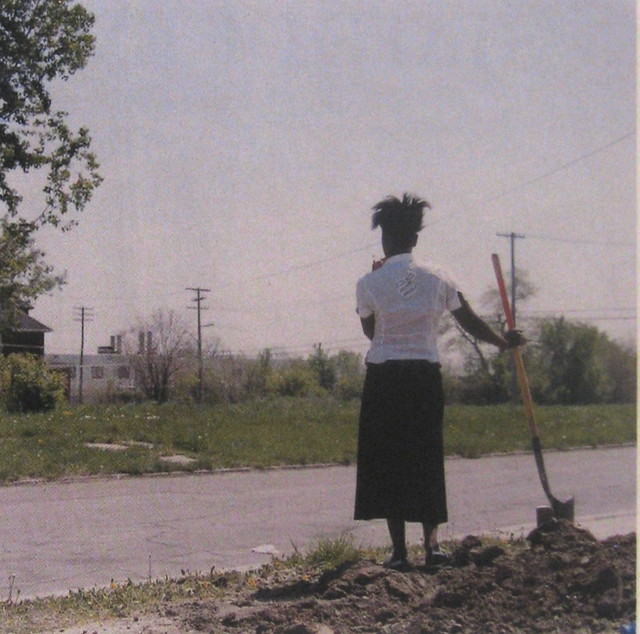Rebecca Solnit's Detroit Arcadia: Exploring the post-American Landscape appears in this month's issue of Harpers's [here, sub required]. For those of you without access to a Harper's subscription, I've provided a copy, here.
I encourage anyone interested in the hollowing out of cities, the abandonment of houses and the shifting landscape of urban America to read and share Solnit's work with your friends and family.
This continent has not seen a transformation like Detroit's since the last days of the Maya.
Artspace • BAVPA • Tour d'Neglect - 2007 • Woodlawn Row Houses • faq • my flickr
the creativity exchange • CEOs for Cities


8 comments:
some people suggested we call buffalo "new buffalo"...how about "mini detroit" instead?
My wife is taking a class in urban economics right now, and we talk about the causes of urbanization and suburbanization. Virtually none of that information was found in the article. Instead, the author likes the narrative of white racism and, "boy the urban prairie is cool isn't it?!" I wasn't impressed by the article.
Keith...
Perhaps you'd care to elaborate with regards to the causes of urbanization and suburbanization.
Did you read the last part? She describes at length the emerging "urban farming" strategy that is helping people who still reside make some sense of where they are living.
while the discussion of urbinization or the faltering therof is interesting it seems that actualy doing something ie. urban farming is a far more productive strategy. any plan that benifits a city with that much loss
and gives people a sense of community at the same time deserves
more credit than do the people who "talk" about it and do very little..ie. nothing. its worth noting that theres plent of room for many differnt ideas and very little other than these type of projects are getting done..and in the case that a better idea comes along then these are ready to build sites. pick the crop and start building. although no one seems to want to do the latter.
Dave, I just read the article today and you're right, that is some heavy stuff. Substitute Buffalo everytime they say Detroit and its even more intense.
Thanks for the article.
Solnit does indeed say "boy, the urban praire is cool." I'm not sure this is "old news" though, and I give her props for making this known to the world, and for describing what Detroit looks like, in lyrical and moving prose. She's not doing sociology, except incidentally, she's doing travelogue, she's describing the landscape of Detroit, with bits of history thrown in. Readers might want the article to be something it is not. It is not a treatise on urbanization or white flight or the causes of suburbanization. Solnit makes it clear that her observations are personal and subjective, but that does not mean that truth cannot be found therein. This in prose poetry about "Acadia" (a clear reference to another poem), not an acamedic paper or an preface for a textbook.
hoping on late...
I just read the article about a month late but I was floored. I have heard horror stories about Detroit from white friends who grew up as the story suggested in the 'burbs but I had no idea.
Actually I still don't any Detroit residents who can confirm the extent of the decay/reclamation of the city. Google Earth is not helping me much.
I just read Solnit’s article – for me, a former Detroit (older suburb) resident (1990-2006), now living in LA, her writing is powerful, realistic and mildly hopeful (as most hope needs to be). Several pieces: the auto industry itself hastened sprawl and central city abandonment – by moving from multi-story to single-story assembly plants, requiring land, huge tracts of land, available & cheap only in outlying areas. Tragically, many of the post-World War 2 suburbs, built on the pillars of the American Dream: home ownership and white flight, are themselves now decaying – the principle remains: abandon the old and build new further out. The older, inner-ring, suburbs, once proudly defining themselves in contrast to the city, are now scrambling to redefine themselves, as their infrastructure ages, working families move out to newer homes, leaving single-parent families and the elderly behind. Sadly, very few in Southeast Michigan have learned “we’re all in this together.” State law and regulation allow the suburbs to compete mercilessly against one another with tax breaks, cannibalizing one another, each striving to secure their future at the expense of the neighbor. Solnit writes: “The future, at least the sustainable one, the one in which we will survive, isn’t going to be invented by people who are happily surrendering selective bits and pieces of environmentally unsound privilege. It’s going to be made by those who had all that taken away from them or never had it in the first place.” Hardship, historically, the mother of invention, is never freely chosen, but imposed. Folks who play at the “new urbanization” are hardly the energy of the radical new, but the folks who wield a shovel and turn a clod of Detroit earth will, like Diego Rivera’s mural workers, create a new Detroit, green and hopeful.
Post a Comment